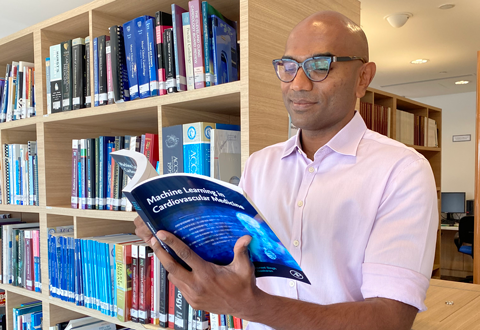
Educating the current and future generation of cardiologists is no easy feat – at times, it even involves publishing a book. Yes, you read that right.
Besides clinical and/or research duties, a few of our clinicians ventured into the complex world of publishing to release their very own books!
Assistant Professor Lohendran Baskaran from the Department of Cardiology (pictured above) is one of the authors of the book titled ‘Machine Learning in Cardiovascular Medicine’. Recently published in November 2020, the book addresses the ever-expanding use of artificial intelligence (AI), specifically delving into how machine learning advancement helps in healthcare and cardiovascular medicine.

Another proud author is Associate Professor Zhong Liang (pictured above), Principle Investigator from National Heart Research Institute Singapore (NHRIS), NHCS, whose book titled ‘Computational and Mathematical Methods in Cardiovascular Physiology’ was first published in 2019.
“With the book, we aimed for two key educational goals – (1) reformatting the Doctor of Medicine (MD) curriculum and courses to educate and train a new generation of physicians who are conversant with medical technologies, and (2) structuring of MD-PhD (Computational Medicine and Surgery) programme, to train competent medical and surgical specialists in precision medical care and patient’s surgical care,” shared Assoc Prof Zhong.
He added that he hoped to show how computational modelling can help support the assessment, diagnosis and treatment planning of the heart’s physiology and disease management, in a non-invasive manner.
We checked in further with newly minted author, Asst Prof Lohendran to find out his inspirations and reflections from writing and publishing his recent book on AI.
What prompted you to write this book?
During the course of my research into coronary artery disease (CAD), I was faced with a deluge of information. To effectively understand the complex relationships found, I read more on the use of AI in other fields, such as in engineering and meteorology.
I realised the depth and power of AI as an analytical tool – to help fellow researchers and clinicians gain insight into critical questions which will in turn, help our patients with heart disease. As I delved more into this field, I came across other researchers and computer scientists who wanted to share their rich experience with others. This spurred me and my co-editors to launch our book.
How was the process of writing and publishing a new book like?
This entire textbook would not have been possible without strong and rewarding collaborations.
Firstly, I worked with co-editors whom I had collaborated with for prior projects and had the same perspectives. This included cardiologist Dr Al'Aref, and two computer scientists based in America, Prof Metaxas and Gurpreet Singh, who are experts at the intersection of computer science and medical imaging.
Secondly, we were fortunate to have a diverse cohort of global contributors from hallmark institutions such as Memorial Sloan Kettering Cancer Centre, New York University, Duke University, Harvard Medical School, University of Milan, and University of Groningen. Clin Assoc Prof Felix Keng who leads NHCS’ Nuclear Cardiology, contributed towards the chapter on AI in Nuclear Cardiology as well.
Another vital factor to the book’s success is Elsevier, the publisher and its dedicated publishing team. The collaborations were arduous but ultimately rewarding – years of work and umpteen revisions across continents forged meaningful friendships and deepened my understanding of the subject. Hopefully, the book is one that people find useful!
What goals do you hope to achieve with your book?
We hope to deliver a book that helps those interested in using AI to tackle the problems faced in cardiovascular medicine regardless of their background.
Definitely, by targeting a diverse group of people, it meant we had to address multiple requirements. For example, clinicians need to understand an overview of AI techniques, the tailored application of a particular algorithm to a particular task, and the limitations of AI (it certainly isn't the magic wand that it has been hyped up to be!). Computer scientists, on the other hand, need to understand the clinical relevance of a particular problem, and that a technical "good result" may not be a clinically pertinent one. As such, this textbook is rather expansive.
Our main goal is that this textbook promotes collaborations between clinician researchers and computer scientists to tackle cardiovascular disease using one of the most effective tools to emerge in this generation: AI.
Any memorable quote from the book?
Oh yes, it’s one from my co-editor, Dr Al'Aref - "The integration of AI can occur throughout the continuum of medicine: from basic laboratory discovery to clinical application and healthcare delivery".
Our doctor-authors are certainly an inspiration for achieving the mean feat of imparting and imprinting their expert knowledge on cardiovascular disease.













 Get it on Google Play
Get it on Google Play